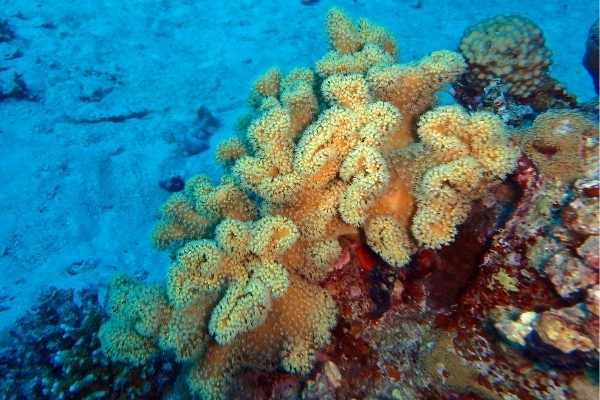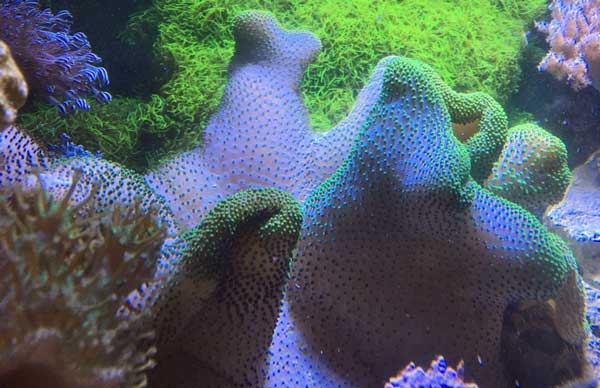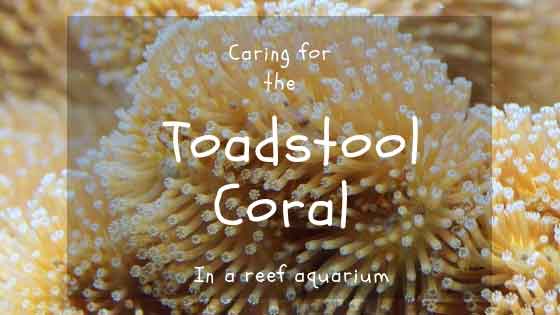[ad_1]
Introduction to caring for the Toadstool Leather Coral
The toadstool coral is a perfect beginner coral for the saltwater aquarium. They are saltwater reef soft coral and require the conditions typical for success with just about any reef tank. Toadstool leather corals are often sold as different varieties, based on their color or the size of their polyps. Long polyped, short polyped, green polyped, and Yellow Fiji Leather are three commonly available varieties of toadstool coral.

This is a fine, wild specimen of the sought after Yellow Fiji Leather Coral
Care requirements in a saltwater aquarium
The toadstool coral is ideally suited to life in a saltwater aquarium. You’ll note that the requirements for care are directly in line with what you would expect with a reef tank.
- Temperature: 72-78 degrees Fahrenheit
- Specific gravity: 1.023-1.025
- Lighting: Moderate
- Water flow: Moderate
- pH: ~8.2
- Harness: 8-12

Love the color pop between this anthias and toadstool coral
Some websites report that they would benefit from the addition of strontium, iodine, and other trace elements, but I have kept Toadstool Corals for years without direct supplementation because they get most of the nutrition they need from light. They have photosynthetic dinoflagellates, called zooxanthellae, that live inside of them and convert the light from your aquarium into life-sustaining sugars through the process of photosynthesis. They are also thought to absorb nutrients directly from the water.
Why are they called Toadstools?
The Toadstool coral gets its name from the resemblance smaller frags have to toadstool mushrooms, which is why you may also see them for sale at your local fish store listed as a mushroom coral.

Before the cap grows large enough to fold up, they do look a bit like toadstools
A Toadstool coral has a long stalk and a small mushroom cap-like top (called a capitulum).
As the cap grows larger, it folds and looks a bit like a carpet anemone.
When the polyps are fully extended, toadstool leather corals almost have a fuzzy appearance. Every night, and a few times during the day, the toadstool will retract its polyps, revealing a smooth surface.
Natural habitat
Toadstool coral is found from the Fiji islands through the Indian Ocean.
Most often, they are sunning themselves in shallow water flat reefs or lagoons, in reefs that are mixed with both soft and hard corals. Shallow water reefs are generally pounded with high-intensity light–so while we often consider this coral to be a moderate-to-low light coral in the aquarium world (because they are tolerant of lower levels of light than many corals), there is no reason to shy away from the beautiful toadstool leather coral if you have a high-intensity reef setup.
Size
Don’t be fooled by the size of a tiny frag. I grew a toadstool coral from a frag the size of a nickel to a colony with a cap that was at least 10 inches in diameter.
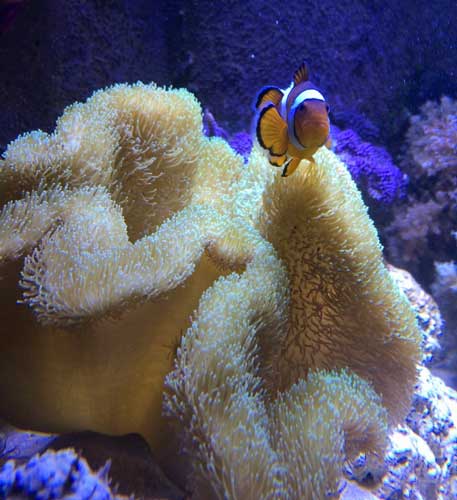
This beauty in my own tank grew from a tiny frag
Toadstool coral care: Compatibility
Toadstool corals don’t have any stinging cells or sweeper tentacles, so in a mixed reef aquarium, they are generally peaceful tankmates. They do produce more than 50 chemicals, at least some of which are thought to have a negative impact on the growth of some small polyp stony (SPS) corals. Even though they come from mixed reefs living alongside stony corals, this is sometimes reported as a problem in the confines of the home aquarium.
Placement
These are not particularly fussy corals. They will do well in multiple areas of the tank. The best general advice is to keep them in areas of moderate flow and light. Not too high, not too low.

Note the green colors on this toadstool
I have historically had a deep sand bed in my 92-gallon tank, so that has meant on the sandbed or mid-level rockwork and on the perimeter of the light. It may be slightly different for you. Just know they don’t need the prime real estate you might otherwise reserve for your SPS corals and may struggle in the twilight or darker regions of the tank that you might otherwise reserve for non-photosynthetic sun coral polyps but will do well in the ~60-70% in between.
Surrogate Anemones for Clownfish
Toadstool corals can make great anemone surrogates for clownfish. Clownfish are needy houseguests. Once bonded, they seem to need constant contact with the polyps and will also clean and peck at the polyps. Toadstool leather corals, in my experience, are fairly tolerant of all this attention.

clownfish nesting in a toadstool coral
Some of the polyps will retract away from all that clownfish love, but I have had a pair hosting in a toadstool leather happily for several years now. However, there are also reports that clownfish may irritate the coral so much that it eventually perishes.
It is important to watch the behavior together to ensure they are growing happily with each other. The clownfish in my tank have actually tried to lay eggs on the toadstool leather coral itself–which was not an effective strategy. The eggs didn’t stick.
You can see the ovipositor from the female coral in the picture below. it’s the blurry (sorry about that, bad photo) white triangle sticking out below the white stripe in the middle of the body. She rubbed and wiggled all over that poor coral for hours trying to get the eggs out and eventually laid a few on a nearby rock.

This clownfish is actually trying to lay eggs on the toadstool
Is my toadstool coral sick?
From time to time, a toadstool coral will retract its polyps, clam up, and release a stringy, gross-looking mucus slime. It is thought to be a way of removing detritus, algae, and other particles from the surface of the coral. Most times this is harmless, but it can be an irritant to other corals.
Toadstool coral shedding
Check out this video to see coral shedding in action.
Reproduction and propagation
According to Borneman, in Aquarium Coral, a toadstool coral reaches maturity in about 6-10 years. Male colonies reach maturity faster and at a smaller size than female colonies (4 x 4 x 4 inches vs. 24 x 24 x inches!!!) That’s a big coral. I can’t wait for the toadstool coral in my home tank to become mature. Better it than me.
They can also make tiny clones of themselves by dropping off tiny bits of the cap or dropping off a small bud from the side. 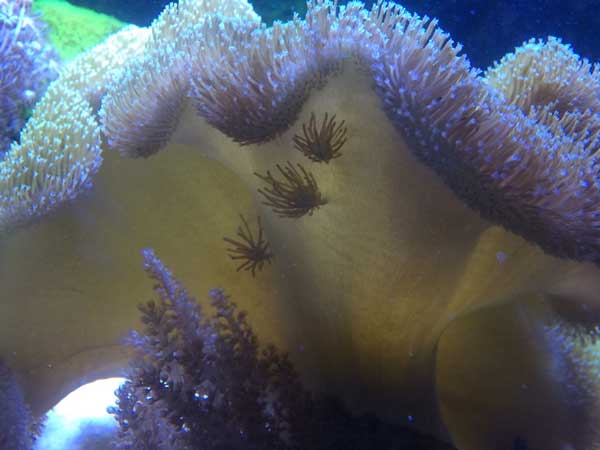
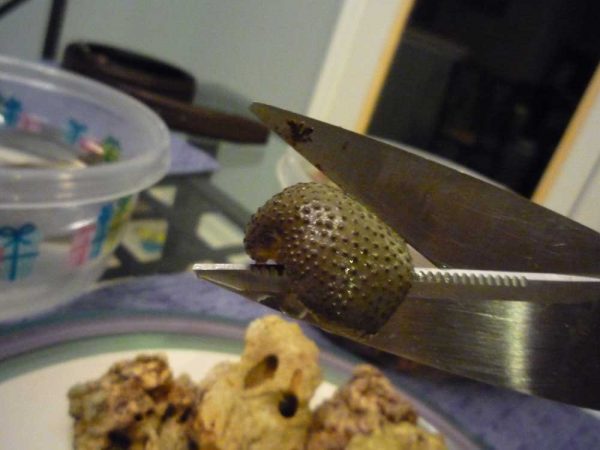
Instead, I find that using the rubber band or plastic mesh methods (described in detail in How to Frag Corals) works best.
Scientific name
The scientific name for the Toadstool coral is a bit tricky because it is quite challenging to tell different species of toadstool corals apart.
Most of the time, I see this genus represented as Sarcophyton sp. Sarcophyton is the genus, but since the species name is not actually known, it is generally abbreviated with the sp. In the case of the Yellow Fiji Leather, the species name is known and can be appropriately referred to as Sarcophyton elegans. Toadstool leather corals are octocorals, or octocorallians–which is a fancy way to say their polyps have 8 tentacles.
Where to buy
Want your own toadstool coral to care for in your saltwater aquarium? The best place to get one, in my opinion, is to make a trade for or purchase a frag from a fellow 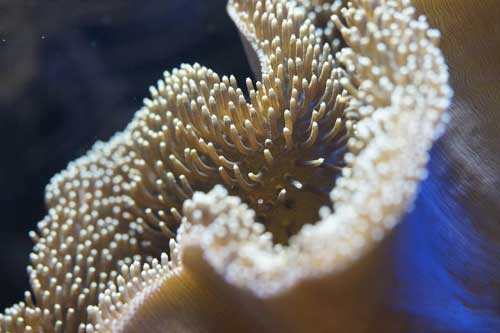
For more information
For more information about setting up your own saltwater aquarium, I recommend The New Saltwater Aquarium Guide. To learn more about how to frag the Toadstool Coral, check out this step-by-step tutorial and pick up my book, How to Frag Corals to learn additional tips and techniques about fragging this and any other coral type.
Written by Albert B. Ulrich III–author of The Reef Aquarium Series of books.
For more information about caring for the toadstool coral, check out this video here:
Or continue learning about other leather coral species:
Follow me on Twitter and Facebook
[ad_2]
Source link

